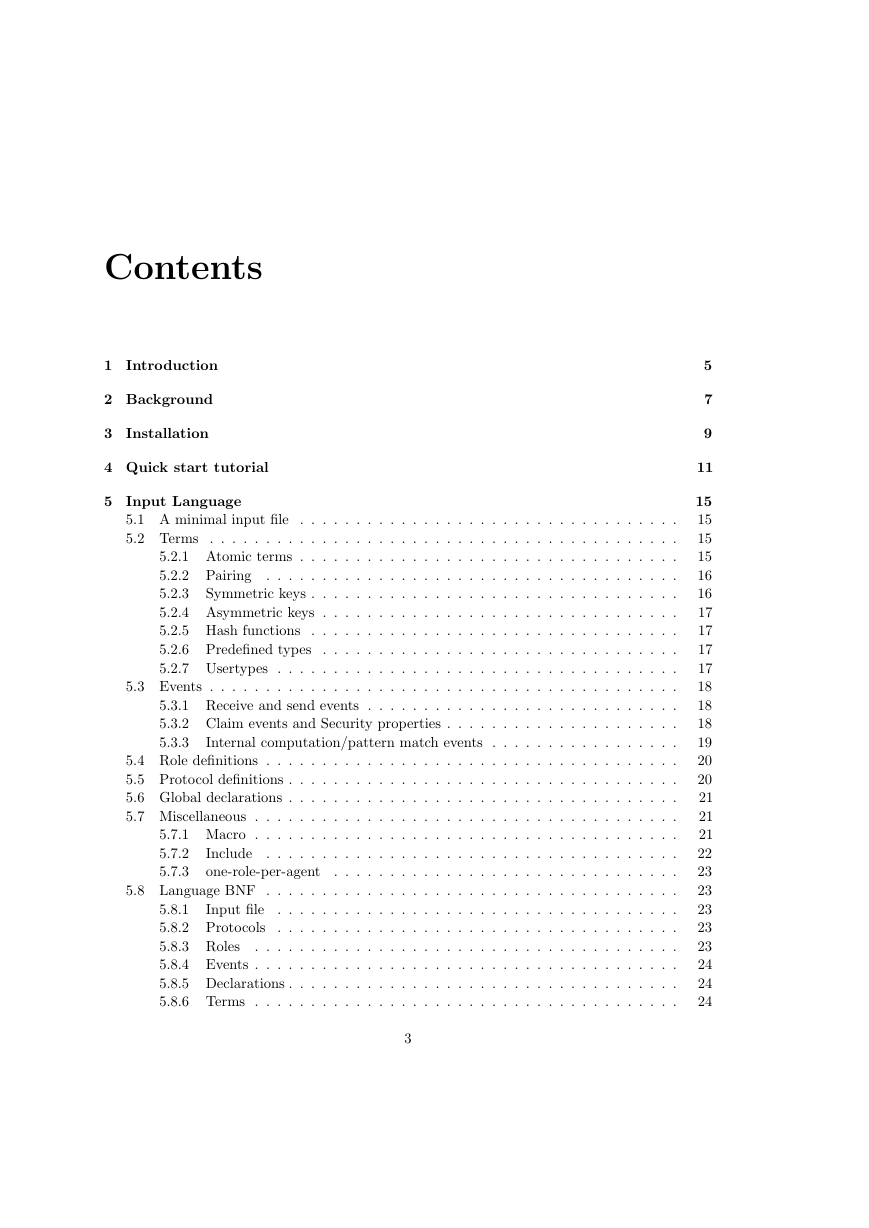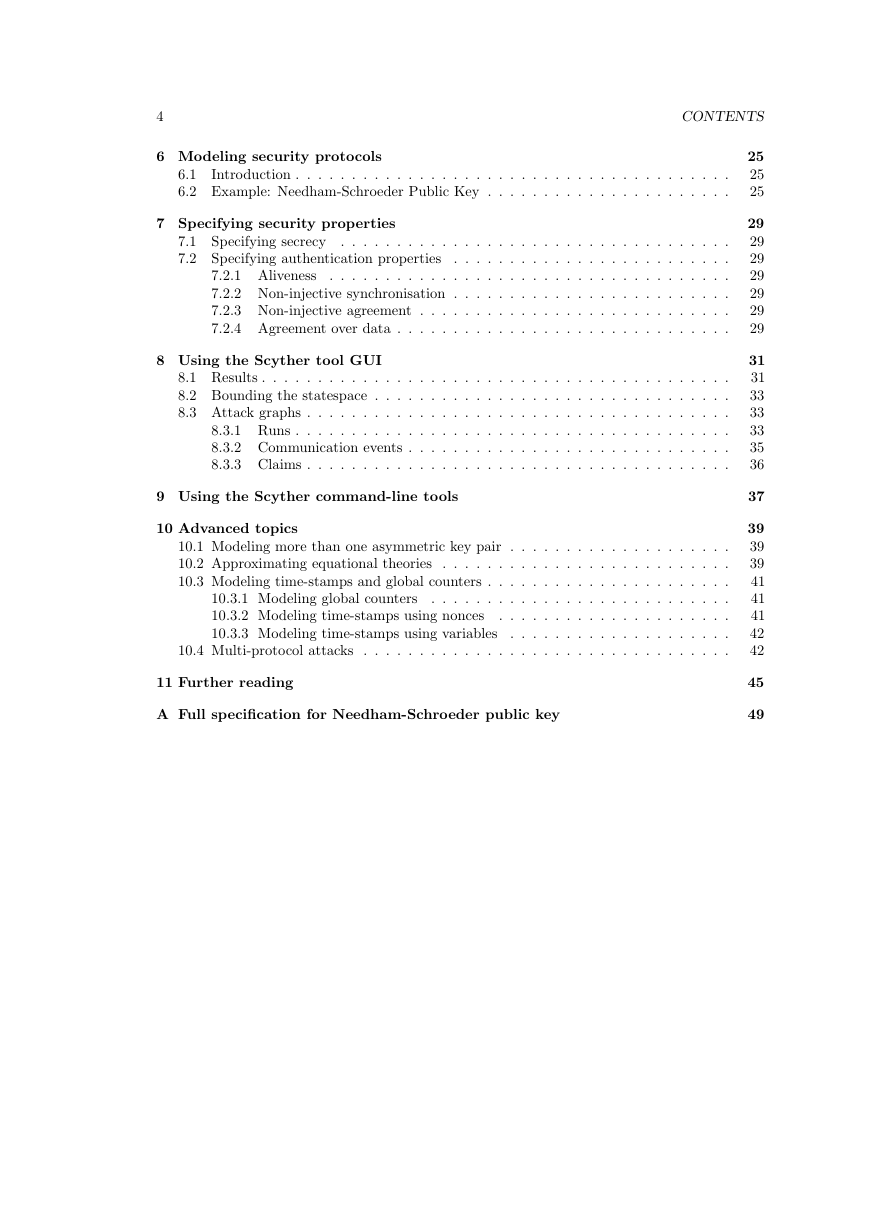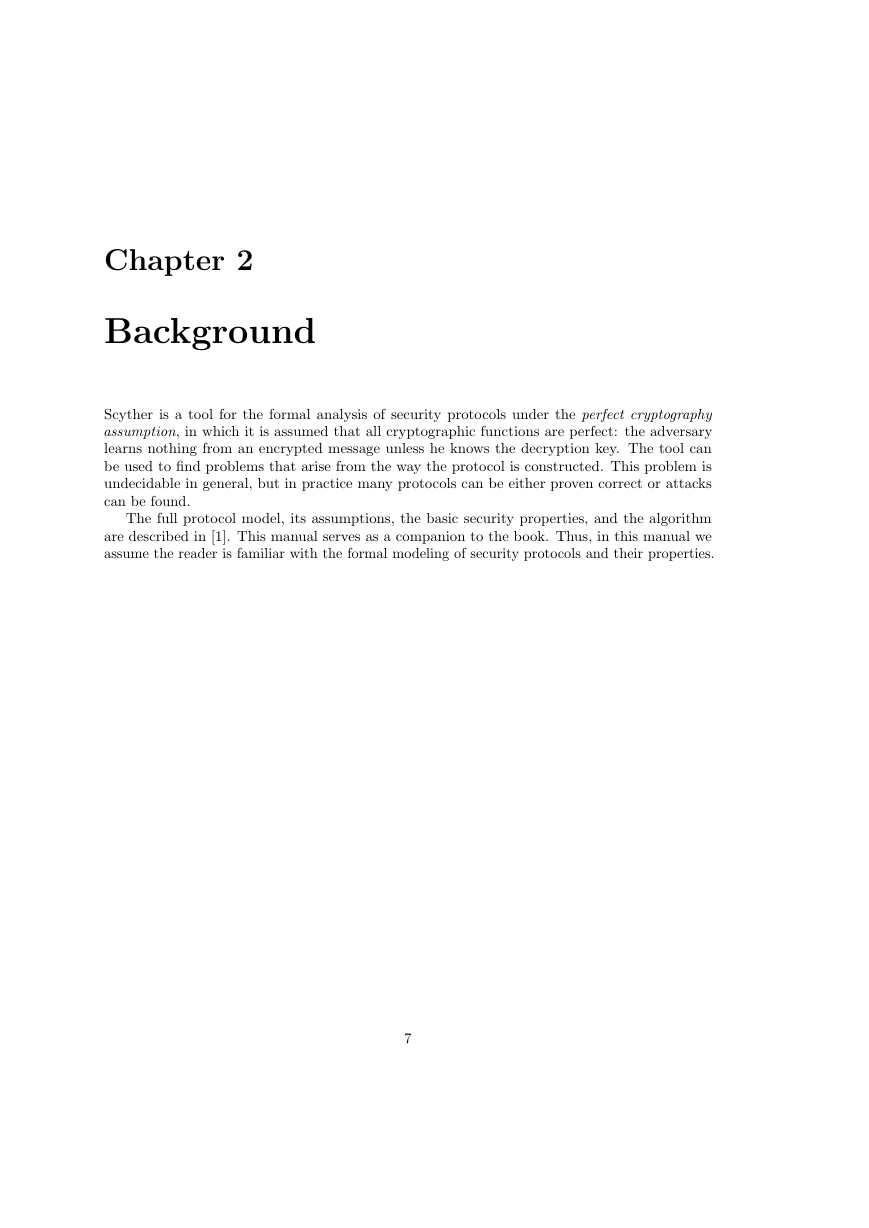Cas Cremers
Scyther
User Manual
Draft February 18, 2014
�
2
�
Contents
1 Introduction
2 Background
3 Installation
4 Quick start tutorial
5 Input Language
5.1 A minimal input file . . . . . . . . . . . . . . . . . . . . . . . . . . . . . . . . . .
5.2 Terms . . . . . . . . . . . . . . . . . . . . . . . . . . . . . . . . . . . . . . . . . .
5.2.1 Atomic terms . . . . . . . . . . . . . . . . . . . . . . . . . . . . . . . . . .
5.2.2 Pairing . . . . . . . . . . . . . . . . . . . . . . . . . . . . . . . . . . . . .
5.2.3
Symmetric keys . . . . . . . . . . . . . . . . . . . . . . . . . . . . . . . . .
5.2.4 Asymmetric keys . . . . . . . . . . . . . . . . . . . . . . . . . . . . . . . .
5.2.5 Hash functions . . . . . . . . . . . . . . . . . . . . . . . . . . . . . . . . .
5.2.6 Predefined types . . . . . . . . . . . . . . . . . . . . . . . . . . . . . . . .
5.2.7 Usertypes . . . . . . . . . . . . . . . . . . . . . . . . . . . . . . . . . . . .
5.3 Events . . . . . . . . . . . . . . . . . . . . . . . . . . . . . . . . . . . . . . . . . .
5.3.1 Receive and send events . . . . . . . . . . . . . . . . . . . . . . . . . . . .
5.3.2 Claim events and Security properties . . . . . . . . . . . . . . . . . . . . .
5.3.3
Internal computation/pattern match events . . . . . . . . . . . . . . . . .
5.4 Role definitions . . . . . . . . . . . . . . . . . . . . . . . . . . . . . . . . . . . . .
5.5 Protocol definitions . . . . . . . . . . . . . . . . . . . . . . . . . . . . . . . . . . .
5.6 Global declarations . . . . . . . . . . . . . . . . . . . . . . . . . . . . . . . . . . .
5.7 Miscellaneous . . . . . . . . . . . . . . . . . . . . . . . . . . . . . . . . . . . . . .
5.7.1 Macro . . . . . . . . . . . . . . . . . . . . . . . . . . . . . . . . . . . . . .
5.7.2
. . . . . . . . . . . . . . . . . . . . . . . . . . . . . . . . . . . . .
. . . . . . . . . . . . . . . . . . . . . . . . . . . . . . .
5.7.3
5.8 Language BNF . . . . . . . . . . . . . . . . . . . . . . . . . . . . . . . . . . . . .
Input file . . . . . . . . . . . . . . . . . . . . . . . . . . . . . . . . . . . .
5.8.1
. . . . . . . . . . . . . . . . . . . . . . . . . . . . . . . . . . . .
5.8.2 Protocols
5.8.3 Roles
. . . . . . . . . . . . . . . . . . . . . . . . . . . . . . . . . . . . . .
5.8.4 Events . . . . . . . . . . . . . . . . . . . . . . . . . . . . . . . . . . . . . .
5.8.5 Declarations . . . . . . . . . . . . . . . . . . . . . . . . . . . . . . . . . . .
5.8.6 Terms . . . . . . . . . . . . . . . . . . . . . . . . . . . . . . . . . . . . . .
Include
one-role-per-agent
3
5
7
9
11
15
15
15
15
16
16
17
17
17
17
18
18
18
19
20
20
21
21
21
22
23
23
23
23
23
24
24
24
�
4
CONTENTS
6 Modeling security protocols
6.1
Introduction . . . . . . . . . . . . . . . . . . . . . . . . . . . . . . . . . . . . . . .
6.2 Example: Needham-Schroeder Public Key . . . . . . . . . . . . . . . . . . . . . .
7 Specifying security properties
7.1 Specifying secrecy . . . . . . . . . . . . . . . . . . . . . . . . . . . . . . . . . . .
7.2 Specifying authentication properties
. . . . . . . . . . . . . . . . . . . . . . . . .
7.2.1 Aliveness
. . . . . . . . . . . . . . . . . . . . . . . . . . . . . . . . . . . .
7.2.2 Non-injective synchronisation . . . . . . . . . . . . . . . . . . . . . . . . .
7.2.3 Non-injective agreement . . . . . . . . . . . . . . . . . . . . . . . . . . . .
7.2.4 Agreement over data . . . . . . . . . . . . . . . . . . . . . . . . . . . . . .
8 Using the Scyther tool GUI
8.1 Results . . . . . . . . . . . . . . . . . . . . . . . . . . . . . . . . . . . . . . . . . .
8.2 Bounding the statespace . . . . . . . . . . . . . . . . . . . . . . . . . . . . . . . .
8.3 Attack graphs . . . . . . . . . . . . . . . . . . . . . . . . . . . . . . . . . . . . . .
8.3.1 Runs . . . . . . . . . . . . . . . . . . . . . . . . . . . . . . . . . . . . . . .
8.3.2 Communication events . . . . . . . . . . . . . . . . . . . . . . . . . . . . .
8.3.3 Claims . . . . . . . . . . . . . . . . . . . . . . . . . . . . . . . . . . . . . .
9 Using the Scyther command-line tools
10 Advanced topics
10.1 Modeling more than one asymmetric key pair . . . . . . . . . . . . . . . . . . . .
10.2 Approximating equational theories . . . . . . . . . . . . . . . . . . . . . . . . . .
10.3 Modeling time-stamps and global counters . . . . . . . . . . . . . . . . . . . . . .
. . . . . . . . . . . . . . . . . . . . . . . . . . .
. . . . . . . . . . . . . . . . . . . . .
. . . . . . . . . . . . . . . . . . . .
10.4 Multi-protocol attacks . . . . . . . . . . . . . . . . . . . . . . . . . . . . . . . . .
10.3.1 Modeling global counters
10.3.2 Modeling time-stamps using nonces
10.3.3 Modeling time-stamps using variables
11 Further reading
A Full specification for Needham-Schroeder public key
25
25
25
29
29
29
29
29
29
29
31
31
33
33
33
35
36
37
39
39
39
41
41
41
42
42
45
49
�
Chapter 1
Introduction
Note: This is a draft of the new version of the Scyther manual. The manual
may therefore be incomplete at points.
Any feedback is welcome and can be sent to Cas Cremers by e-mail:
cas.cremers@cs.ox.ac.uk.
This is the user manual for the Scyther security protocol verification tool.
The purpose of this manual is to explain the details of the Scyther input language, explain
how to model basic protocols, and how to effectively use the Scyther tool. This manual does not
detail the protocol execution model nor the adversary model used by the tool. It is therefore
highly recommended to read the accompanying book [1]. The book includes a detailed description
of Scyther’s underlying protocol model, security property specifications, and the algorithm.
We proceed in the following way. Some background is given in Chapter 2. Chapter 3 explains
how to install the Scyther tool on various platforms. In Chapter 4 we give a brief tutorial using
simple examples to show the basics of the tool. Then we discuss things in more detail as we
introduce the input language of the tool in Chapter 5. Modeling of basic protocols is described in
Chapter 6, and Chapter 7 describes how to specify security properties. The usage of the GUI
version of tool is then explained in more detail in Section 8. The underlying command-line tool is
described in Section 9. Advanced topics are discussed in Section 10.
Online information
More help can be found online on the Scyther website:
http://users.ox.ac.uk/~coml0529/scyther/index.html
Users are advised to subscribe to the Scyther mailing list, whose details can also be found on the
Scyther website.
5
�
6
CHAPTER 1.
INTRODUCTION
�
Chapter 2
Background
Scyther is a tool for the formal analysis of security protocols under the perfect cryptography
assumption, in which it is assumed that all cryptographic functions are perfect: the adversary
learns nothing from an encrypted message unless he knows the decryption key. The tool can
be used to find problems that arise from the way the protocol is constructed. This problem is
undecidable in general, but in practice many protocols can be either proven correct or attacks
can be found.
The full protocol model, its assumptions, the basic security properties, and the algorithm
are described in [1]. This manual serves as a companion to the book. Thus, in this manual we
assume the reader is familiar with the formal modeling of security protocols and their properties.
7
�
8
CHAPTER 2. BACKGROUND
�
















 2023年江西萍乡中考道德与法治真题及答案.doc
2023年江西萍乡中考道德与法治真题及答案.doc 2012年重庆南川中考生物真题及答案.doc
2012年重庆南川中考生物真题及答案.doc 2013年江西师范大学地理学综合及文艺理论基础考研真题.doc
2013年江西师范大学地理学综合及文艺理论基础考研真题.doc 2020年四川甘孜小升初语文真题及答案I卷.doc
2020年四川甘孜小升初语文真题及答案I卷.doc 2020年注册岩土工程师专业基础考试真题及答案.doc
2020年注册岩土工程师专业基础考试真题及答案.doc 2023-2024学年福建省厦门市九年级上学期数学月考试题及答案.doc
2023-2024学年福建省厦门市九年级上学期数学月考试题及答案.doc 2021-2022学年辽宁省沈阳市大东区九年级上学期语文期末试题及答案.doc
2021-2022学年辽宁省沈阳市大东区九年级上学期语文期末试题及答案.doc 2022-2023学年北京东城区初三第一学期物理期末试卷及答案.doc
2022-2023学年北京东城区初三第一学期物理期末试卷及答案.doc 2018上半年江西教师资格初中地理学科知识与教学能力真题及答案.doc
2018上半年江西教师资格初中地理学科知识与教学能力真题及答案.doc 2012年河北国家公务员申论考试真题及答案-省级.doc
2012年河北国家公务员申论考试真题及答案-省级.doc 2020-2021学年江苏省扬州市江都区邵樊片九年级上学期数学第一次质量检测试题及答案.doc
2020-2021学年江苏省扬州市江都区邵樊片九年级上学期数学第一次质量检测试题及答案.doc 2022下半年黑龙江教师资格证中学综合素质真题及答案.doc
2022下半年黑龙江教师资格证中学综合素质真题及答案.doc